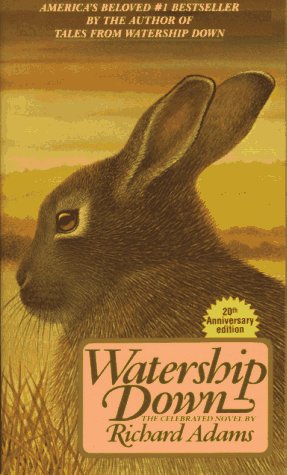Thursday, November 12, 2009
Watership Down
Fiver has a "bad feeling about this." Something's wrong, and everyone needs to leave. Unfortunately, only Fiver's good friend Hazel believes him. Hazel, however, is able to convince a few others that leaving is going to be a good idea. So without knowing where exactly they are going, the group heads out on an adventure to find a new home. Oh, and they are all rabbits.
On a matter of scale, the journey the rabbits go on isn't quite the same as going from the Shire to Mordor, but there is no question that their travel isn't just as epic as that of the hobbits. Richard Adams has anthropomorphized the rabbits in such a way that their concerns, their emotions, and the fears that they face are eminently human. By mixing in bits and pieces of the rabbit language, and crafting a cultural history and mythology for the rabbits and showing their interactions with rabbits from other warrens he imbues the characters with depth and complexity that many authors fail to provide to their human characters. Hazel, well-spoken and a natural leader despite his own self-doubt; Fiver, undersized but respected because of his connection with the spiritual world; Bigwig, self-confident and capable, but aware of his own limitations. The level of development which Adams provides to his characters is really amazing.
And the scale of his story is perfectly suited to a group of rabbits. Even the things which seem unlikely at first glance -- 20 rabbits climbing into a boat and floating down a river -- work, and they work because Adams pays attention to detail and explains things in a way which never shifts the reader out of the story. As soon as you pick up the book, you're deeply enmeshed in the story and the world. And it is interesting that Adams seems to try to avoid any moralizing about the interactions of humans and nature. There are a few brief comments about it when the rabbits' home warren is destroyed to make way for a building development (the cause of the bad feeling that Fiver had), but it is limited to the horror that the rabbits experience when trying to understand something which is so outside of their ability to understand. That is something that I feel like many authors would not be willing to avoid doing nowadays.
One aspect of the story that remains distinctly non-human is the separation between male and female roles in rabbit society. Females aren't especially important beyond being the ones who generally do the digging to expand a warren and for procreation. There is no discussion of love, or romance, the does are regarded simply as objects. I think that this was intentional on Adams' part, but not representative of his beliefs, or as something he was encouraging. Despite their anthropomorphism, the characters in Watership Down are rabbits. They aren't human, and so can't be expected to have all of the same characteristics of humans. Perhaps love is a distinctly human trait in Adams' mind, whereas things such as bravery, respect, honor, duty, and other "higher" traits are characteristics which animals might actually share with humans.
Score: 4 out of 5
Subscribe to:
Post Comments (Atom)


No comments:
Post a Comment